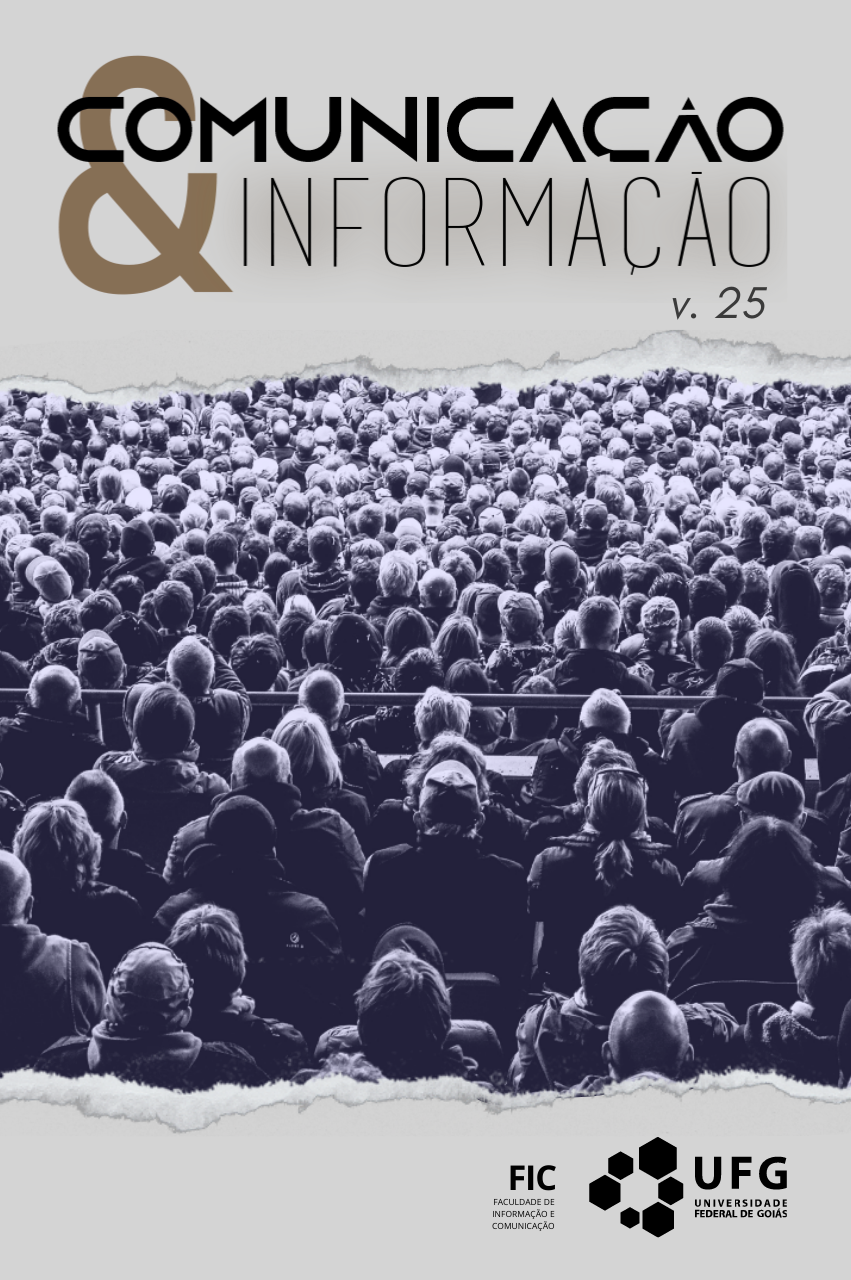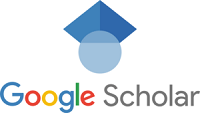Fatores influentes na formulação matemática do Fator de Impacto de periódicos científicos
DOI:
https://doi.org/10.5216/ci.v25.63496Palavras-chave:
Comunicação e Informação. Produção científica. Avaliação de Periódicos. Fator de Impacto.Resumo
A presente pesquisa teve como objetivo de identificar os principais fatores que influenciam na formulação matemática do cálculo do Fator de Impacto dos periódicos científicos. Adotou uma pesquisa bibliográfica para a fundamentação teórica e coleta das informações dos trabalhos e autores. Os resultados apontaram que os tipos de documentos, distribuição do número de citação, cobertura da base de dados, valor numérico e fundamentos da lei de dispersão de Bradford, reúnem bases teóricas que influenciam na formulação matemática do cálculo desse indicador. Neste contexto, ressalta-se a necessidade do desenvolvimento de estudos brasileiros que contribuam para as reflexões, discussões e aprimoramento do conhecimento relativo ao Fator de Impacto e suas implicações principalmente nas áreas de ciências sociais aplicadas.
Downloads
Referências
ALLISON, P. D. Discrete-time methods for the analysis of event histories. Sociological Methodology, USA, v. 13, p. 61-98,1982. Disponível em: https://statisticalhorizons.com/w p-content/uploads/Allison.SM82.pdf. Acesso em: 10 maio 2016.
ALLISON, P. D.; WATERMAN, R. P. Fixed-effects negative binomial regression models. Sociological Methodology, USA, v. 32, p. 247-265, 2002. doi: 10.1111/1467-9531.00117.
ALMEIDA, C. C; GRÁCIO, M. C. C. Scientific impact indicator: a comparative study of Brazilian Journals’ impact factors. In: INTERNATIONAL CONFERENCE ON SCIENCE AND TECHNOLOGY INDICATORS, 21., 2016a, València. Proceedings […].València: Editorial Universitat Politecnica de Valencia, 2016a.
ALMEIDA, C. C; GRÁCIO, M. C. C. Impacto dos periódicos brasileiros na área de Ciências Sociais: um estudo comparativo entre as bases Scopus e SciELO. In: ENCONTRO NACIONAL DE PESQUISA EM CIÊNCIA DA INFORMAÇÃO, 17., 2016b, Salvador. Anais [...]. Salvador: ENANCIB, 2016b.
ALMEIDA, C. C; GRACIO, M. C. C. Citações de artigos em periódicos em de Ciência da Informação: uma análise da distribuição na base Scopus. In: ENCONTRO NACIONAL DE PESQUISA EM CIÊNCIA DA INFORMAÇÃO, 18., 2017a, Marília, SP. Anais [...]. Marília, SP: ENANCIB, 2017a. Disponível em: http://www.brapci.inf.br/index.php/article/download/58891. Acesso em: 10 maio 2018.
ALMEIDA, C. C; GRACIO, M. C. C. Factor de impacto de revistas de la América Latina en Ciencia Social: Un estudio comparativo entre las bases Scopus y Web of Science. Revista Científica Guillermo de Ockham, Columbia, v. 15, n. 2, p. 1-13, 2017b. Disponível em: https://revistas.usb.edu.co/index.php/GuillermoOckham/issue/view/256. Acesso em: 15 maio 2018.
ARCHAMBAULT, E.; LARIVIÈRE, V. History of the journal impact factor: Contingencies and consequences. Scientometrics, Netherlands, v. 79, n. 3, p. 639–653; 2009. doi: 10.1007/s 11192-007-2036-x.
BARATA, R. C. B. Dez coisas que você deveria saber sobre o Qualis. RBPG, Brasília, v. 13, n. 30, p. 13-40, jan./abr. 2016. Disponível em: ojs.rbpg.capes.gov.br
/index.php/rbpg/article/download/947/pdf. Acesso em: 20 nov. 2016.
BENSMAN, S. J. Garfield and the impact factor. Annual Review of Information Science and Technology, New York, v. 41, n. 1, p. 93-155, 2007. Disponível em: http://onlinelibrary.wiley.com/doi/10.1002/aris.2007.1440410110/pdf Acesso em: 12 dez. 2017.
BRADFORD, S C. Sources of information on specific subjects. Engineering, London, v. 137, n. 85-6, 1934.
BRAUN, T.; GLÄNZEL, W.; SCHUBERT, A. The footmarks of Eugene Garfield in the journal Scientometrics. Annals of Library and Information Studies, India, v. 57, p. 177-183, 2010. Disponível em: http://nopr.niscair.res.in/bitstream/123456789/10231
/4/ALIS%2057(3)%20177-183.pdf. Acesso em: 10 mar. 2018.
CANTRILL, S. Nature Chemistry’s 2014 impact factor citation distribution. Nature Chemistry, Blog The Sceptical Chymist, 2015. Disponível em: http://blogs.nature.com/thescepticalchymist/2015/12/nature-chemistrys-2014-impact-factor
-citation-distribution.html. Acesso em: 15 maio 2018.
CLARIVATE ANALYTICS. The clarivate analytics impact factor. Clarivate, 2018. Disponível em: https://clarivate.com/essays/impact-factor/. Acesso em: 5 jan. 2018.
DE BELLIS, N. Bibliometrics and citation analysis: from the science citation index to cybermetrics. Toronto: The Scarecrow Press, 2009.
DONG, P.; LOH, M.; MONDRY, A. The "impact factor" revisited. Biomedical Digital Libraries, United Kingdom, v. 2, n. 7, 2005. Disponível em: https://bio-diglib.biomedcentral. com/articles/10.1186/1742-5581-2-7. Acesso em: 12 nov. 2016.
DURAND-BARTHEZ, M. Historique et critique du facteur d’impact. Schedae, France, v. 7, n. 1, p. 67-76, 2008. Disponível em: https://hal.archives-ouvertes.fr/hal-01356185/document. Acesso em: 20 fev. 2018.
FERNANDÉZ-LLIMÓS, F. S. Análisis de la cobertura del concepto de pharmaceutical care en fuentes primarias y secundarias de información. 2003. 266 f. Tesis (Farmacia Asistencial) - Universidad de Granada, Departamento de Farmacia y Tecnologia Farmacéutica, Granada, 2003.
GARFIELD, E. Citation indexes for science: A new dimension in documentation through association of ideas. Science, USA, v. 122, n. 3159, p. 108–11,1955. Disponível em: http://garfield.library.upenn.edu/papers/science1955.pdf. Acesso em: 10 dez. 2017.
GARFIELD, E.; SHER, I. H. New factors in the evaluation of scientific literature through citation indexing. American Documentation, USA, v. 4, n. 3, p. 195-201, 1963. Disponível em: http://garfield.library.upenn.edu/essays/v6p492y1983.pdf. Acesso em 11 nov. 2017.
GARFIELD E. Citation analysis as a tool in journal evaluation. Science, USA, v. 17, p. 471-479, 1972a. Disponível em: http://www.garfield.library.upenn.edu/essays/V1p527
y1962-73.pdf. Acesso em 11 nov. 2017.
GARFIELD E. Citation statistics may help scientists choose journals in which to publish. Current Contents, Philadelphia, v. 6, p. 5-6, 1972b. Disponível em: http://www.garfield. library.upenn.edu/. Acesso em: 11 nov. 2017.
GARFIELD E. Is the ratio between number of citations and publications cited a true constant? Current Contents, Philadelphia, v. 6, n. 5-7, 1976. Disponível em: http://garfield.library.upenn.edu/essays/v2p419y1974-76.pdf. Acesso em: 12 dez. 2017.
GARFIELD E. Reviewing review literature part.1 definitions and uses of reviews. Current Contents, Philadelphia, n. 18, p. 5-8; 1987. Disponível em: http://www.garfield.library.upenn.edu/essays/v10p113y1987.pdf. Acesso em: 12 dez. 2017.
GARFIELD E. Journal impact factor: a brief review. Canadian Medical Association Journal, Canadian, v. 161, n. 8, p. 979-980, 1999. Disponível em: http://www.garfield.library.upenn.edu/papers/JournalimpactCMAJ1999.pdf. Acesso em: 20 nov. 2017.
GLÄNZEL, W. Bibliometrics as a research field: a course on theory and application of bibliometric indicators. Budapeste: Academia Húngara de Ciências, 2003.
GLÄNZEL, W. The multi-dimensionality of impact factor. Scientometrics, Netherlands, v. 78, 2009. doi: 10.1007/s11192-008-2166-9.
GLÄNZEL, W.; MOED, F. H. Opinion paper: thoughts and facts on bibliometric indicators. Scientometrics, Netherland, v. 96, n. 1, p. 381-394, 2013. doi: 10.1007/s11192-012-0898-z.
GOTTLIEB, L. N.; CLARKE, S. P. Impact factors and the law of unintended consequences. CJNR, Montréal, v. 37, n. 4, p. 5-10, 2005. Disponível em: cjnr.archive.mcgill.ca/article/download/1967/1961. Acesso em 22 fev. 2018.
HAMILTON, D. Publishing by–and for? – the numbers. Science, Washington, v. 250, n. 4986, p. 1331-1332, 1990. doi: 10.1126/science.2255902.
LARIVIÈRE, V.; KIERMER, V.; MACCALLUM, J. C.; MCNUTT, M.; PATTERSON, M.; PULVERER, B.; SWAMINATHAN, S.; TAYLOR, S.; CURRY S. A simple proposal of journal citation distributions. bioRxiv, New York, 2016. doi: 10.1101/062109.
LIU, X-L; GAI, S-S; ZHANG, S-L; WANG, P. An Analysis of peer-reviewed scores and impact factors with different citation time windows: a case study of 28 Ophthalmologic Journals. PLOS ONE, USA, v. 10, n. 8, 2015. Disponível em: https://journals.plos.org/Plosone/article?id=10.1371/journal.pone.0135583. Acesso em: 9 dez. 2017.
MACIAS-CHAPULA, C. A. O papel da informetria e da cienciometria e sua perspectiva nacional e internacional. Ciência da Informação, Brasília, v. 27, n. 2, p.134-40, maio/ago. 1998.
MOED, H; VAN LEEUWEN, T. Improving the accuracy of Institute for Scientific Information’s Journal impact factors. Journal of the American Society for information Science, USA, v. 46, n. 6, p. 461-467, 1995. Disponível em: https://doi.org/10.1002/(SICI)1097-4571(199507)46:6<461::AID-ASI5>3.0.CO;2-G. Acesso em: 22 mar. 2017.
MOED, H.; VAN LEEUWEN, T. Impact factors can mislead. Nature, United Kingdom, v. 381, n. 186, 1996. Disponível em: https://www.nature.com/articles/381186a0. Acesso em:
abr. 2017.
MURALI, N. S; MURALI, H. R; AUETHAVEKIA, T. P.; ERWIN, P. J.; MANDREKAR, J. N.; MANEK, N. J; GHOSH, A.K. Impact of FUTON and NAA bias on visibility of research. Mayo Clinic Porceedings, USA, v. 79, n. 8, p. 1001-1006, 2004. doi: 10.4065/79.8.1001.
POTTER, I. Beyond the impact factor: taking a wider view of journal evaluation. Insights: the UKSG Journal, United Kingdom, v. 29, n. 1, p. 70–77, 2016. Disponível em: https://insights.uksg.org/articles/10.1629/uksg.287/. Acesso em: 15 maio 2018:
SEGLEN, P.O. Citations and journal impact factors: questionable indicators of research quality. Allergy, Germany, v. 52, v. 11, p. 1050-1056, 1997. Doi: 10.1111/j.1398-9995.1997.tb00175.x
SEN, B. K. Changes in impact factor. Malaysian Journal of Library & Information Science, Malaya, v. 4, n. 2, p. 41-46, 1999. Disponível em: http://majlis.fsktm.um.edu.my/
document.aspx?FileName=147.pdf. Acesso em: 15 dez. 2017.
SEN, B. K. Eugene Garfield–Glimpses of his writings. Journal Scientometric Research, Índia, v. 3, n. 1, 2014. Disponível em: https://www.jscires.org/sites/default/files/JSci
Res_2014_3_1_57_143709.pdf.Acesso em 15 dez. 2017.
SCHUBERT, A.; SCHUBERT, G. Whatever happened to Garfield’s constant? Scientometrics, Netherlands, v. 114, n. 2, p. 659-667, 2018. doi: 10.1007/s11192-017-2527-3.
SIMONS, K. The misused Impact Factor. Science, USA, v. 322, n. 5899, p. 165, 2008. doi: 10.1126/science.1165316.
SMIT, E. S. Obsolescence and impact on reliability: a further development of internet triangulation. Work Completion of Course (Bachelor in International Business Administration) - University of Twente, Enschede, Países Baixos, 2017. Disponível em: https://essay.utwente.nl/72544/1/Smit_BA_BMS%5B1%5D.pdf. Acesso em: 10 fev. 2018.
SPINAK, E. Indicadores cienciométricos. Brasília, Ciência da Informação, v. 27, n. 2, p. 141-148; 1998.
VAN LEEUWEN, T.; MOED, H. Development and application of New Journal Impact Measures. Cortex, France, v. 37, n. 4, p. 607-610, 2001. doi: 10.1016/S0010-9452(08)70607-5.
VAN LEEUWEN, T.; MOED, H. Development and application of journal impact measures in the Dutch science system. Scientometrics, Netherlands, v. 53, p. 249, 2002. doi: 10.1023/A:1014808709694.
VAN LEEUWEN, T.; MOED, H. Characteristics of journal impact factors: The effects of uncitedness and citation distribution on the understanding of journal impact factors. Scientometrics, Netherlands, v. 63, n. 2, p. 357-371, 2005. doi: 10.1007/s11192-005-0217-z.
VAN LEEUWEN, T. Discussing some basic critique on Journal Impact Factors: revision of earlier comments. Scientometrics, Netherlands, v. 92, p. 443–455, 2012. doi: 10.1007/s11192-012-0677-x.
VANCLAY, J. K. Bias in the journal impact factor. Scientometrics, Netherlands, v. 78, n. 1, p. 3-12, 2009. doi: 10.1007/s11192-008-1778-4.
VINKLER, P. Model for quantitative selection of relative scientometric impact indicators. Scientometrics, Netherlands, v. 36, p. 223-236, 1996. doi: 10.1007/bf02017315.
VINKLER, P. Subfield problems in applying the Garfield (Impact) Factors in practice. Scientometrics, Netherlands, v. 53, n. 2, p. 267-279, 2002. doi: 10.1023/A:1014860726532.
VINKLER, P. Relations of relative scientometric indicators. Scientometrics, Netherlands, v. 58, n. 3, p. 687-694, 2003. doi: 10.1023/B:SCIE.0000006888.69146.24.
WALTMAN, L. A review of the literature on citation impact indicators. Journal of Informetrics, Netherlands, v.10, n. 2, p. 365-391, 2016. doi: 10.1016/j.joi.2016.02.007.
WEALE, A. R.; BAILEY, M.; LEAR, P. A. The level of non-citation of articles within a journal as a measure of quality: a comparison to the impact factor. BMC Medical Research Methodology, United Kingdom, v. 4, n. 14, 2004. Disponível em: https://bmcmed
resMethodol.biomedcentral.com/articles/10.1186/1471-2288-4-14. Acesso: 15 abr. 2018.
WHITEHOUSE, G.H. Citation rates and impact factors: should they matter? The British Journal of Radiology, United Kingdom, v. 74, n. 877, p. 1-3, 2001. doi: 10.1259/bjr.74.877.740001.
WOUTERS, P. The citation culture. 1999. 278 f. Tese (Doutorado em Ciências) University of Amsterdan, Faculty of Science, Netherlands, 1999. Disponível em: https://dare.uva.nl/Search?identifier=b101b769-100f-43e5-b8d2-cac6c11e5bbf.
Acesso em: 22 nov. 2017.
Downloads
Publicado
Como Citar
Edição
Seção
Licença
Os autores dos trabalhos publicados na revista Comunicação e Informação retêm os direitos autorais sem restrições e concedem à revista o direito de primeira publicação, com o trabalho simultâneo licenciado sob a Licença Creative Commons Atribuição-NãoComercial que permite o compartilhamento do trabalho para fins não comerciais com reconhecimento da autoria e o privilégio de publicação primeiramente por esta revista. Caso o texto venha a ser publicado posteriormente em outro veículo, solicita-se aos autores informar que o mesmo foi originalmente publicado como artigo na revista Perspectiva, bem como citar as referências bibliográficas completas dessa publicação.
Os direitos autorais dos artigos pertencem aos autores e o conteúdo dos artigos assinados é de responsabilidade exclusiva dos autores.
A revista se reserva o direito de efetuar, nos originais, alterações de ordem normativa, ortográfica e gramatical, com o intuito de manter o padrão culto da língua, respeitando, porém, o estilo dos autores.
A revista também se reserva o direito de traduzir o artigo, no todo ou em parte, para o inglês ou para o português, dependendo do idioma em que o artigo tenha sido escrito originalmente.



